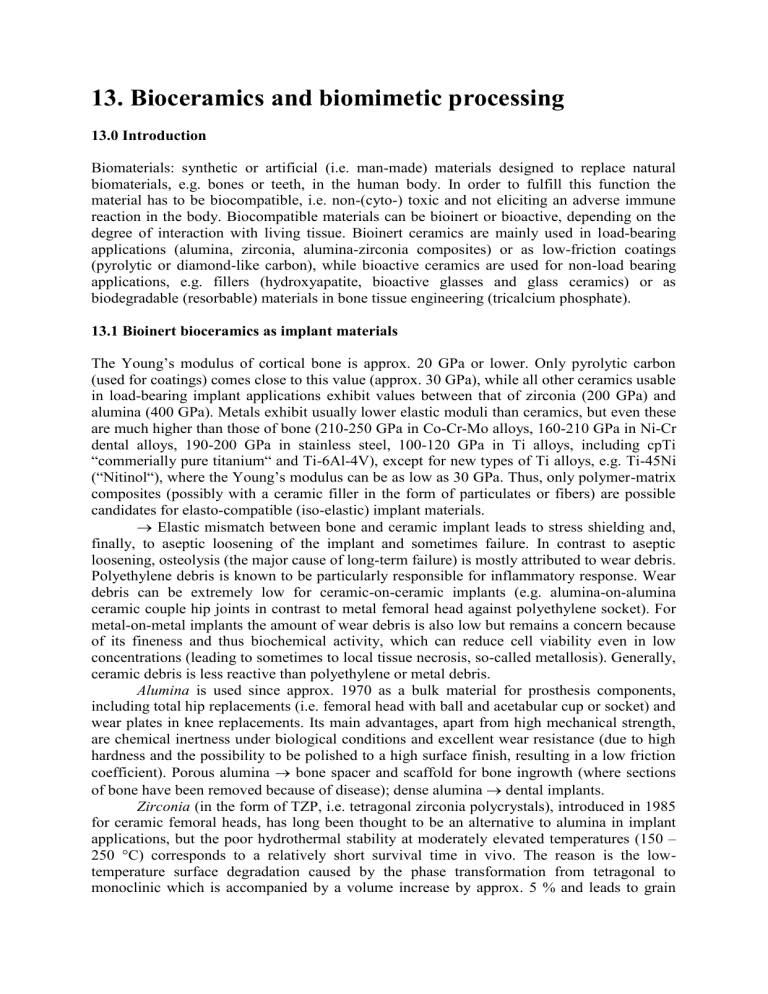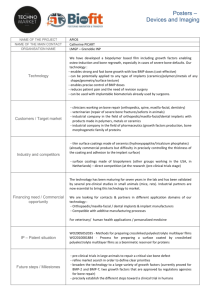13. Bioceramics and biomimetic processing

13. Bioceramics and biomimetic processing
13.0 Introduction
Biomaterials: synthetic or artificial (i.e. man-made) materials designed to replace natural biomaterials, e.g. bones or teeth, in the human body. In order to fulfill this function the material has to be biocompatible, i.e. non-(cyto-) toxic and not eliciting an adverse immune reaction in the body. Biocompatible materials can be bioinert or bioactive, depending on the degree of interaction with living tissue. Bioinert ceramics are mainly used in load-bearing applications (alumina, zirconia, alumina-zirconia composites) or as low-friction coatings
(pyrolytic or diamond-like carbon), while bioactive ceramics are used for non-load bearing applications, e.g. fillers (hydroxyapatite, bioactive glasses and glass ceramics) or as biodegradable (resorbable) materials in bone tissue engineering (tricalcium phosphate).
13.1 Bioinert bioceramics as implant materials
The Young’s modulus of cortical bone is approx. 20 GPa or lower. Only pyrolytic carbon
(used for coatings) comes close to this value (approx. 30 GPa), while all other ceramics usable in load-bearing implant applications exhibit values between that of zirconia (200 GPa) and alumina (400 GPa). Metals exhibit usually lower elastic moduli than ceramics, but even these are much higher than those of bone (210-250 GPa in Co-Cr-Mo alloys, 160-210 GPa in Ni-Cr dental alloys, 190-200 GPa in stainless steel, 100-120 GPa in Ti alloys, including cpTi
“commerially pure titanium“ and Ti-6Al-4V), except for new types of Ti alloys, e.g. Ti-45Ni
(“Nitinol“), where the Young’s modulus can be as low as 30 GPa. Thus, only polymer-matrix composites (possibly with a ceramic filler in the form of particulates or fibers) are possible candidates for elasto-compatible (iso-elastic) implant materials.
Elastic mismatch between bone and ceramic implant leads to stress shielding and, finally, to aseptic loosening of the implant and sometimes failure. In contrast to aseptic loosening, osteolysis (the major cause of long-term failure) is mostly attributed to wear debris.
Polyethylene debris is known to be particularly responsible for inflammatory response. Wear debris can be extremely low for ceramic-on-ceramic implants (e.g. alumina-on-alumina ceramic couple hip joints in contrast to metal femoral head against polyethylene socket). For metal-on-metal implants the amount of wear debris is also low but remains a concern because of its fineness and thus biochemical activity, which can reduce cell viability even in low concentrations (leading to sometimes to local tissue necrosis, so-called metallosis). Generally, ceramic debris is less reactive than polyethylene or metal debris.
Alumina is used since approx. 1970 as a bulk material for prosthesis components, including total hip replacements (i.e. femoral head with ball and acetabular cup or socket) and wear plates in knee replacements. Its main advantages, apart from high mechanical strength, are chemical inertness under biological conditions and excellent wear resistance (due to high hardness and the possibility to be polished to a high surface finish, resulting in a low friction coefficient). Porous alumina
bone spacer and scaffold for bone ingrowth (where sections of bone have been removed because of disease); dense alumina
dental implants.
Zirconia (in the form of TZP, i.e. tetragonal zirconia polycrystals), introduced in 1985 for ceramic femoral heads, has long been thought to be an alternative to alumina in implant applications, but the poor hydrothermal stability at moderately elevated temperatures (150 –
250 °C) corresponds to a relatively short survival time in vivo. The reason is the lowtemperature surface degradation caused by the phase transformation from tetragonal to monoclinic which is accompanied by a volume increase by approx. 5 % and leads to grain
pullout and increased wear or even catastrophic failure. It is known, however, that alumina increases the resistance against this hydrothermal aging effect. Thus, only alumina-containing zirconia ceramics can be an alternative to pure alumina for implant applications. Alumina additions in zirconia range from very small (0.25 wt.%) to alumina-zirconia composites with alumina as the prevalent phase (ZTA, i.e. zirconia-toughened alumina), e.g. 85 – 75 wt.% alumina and 15 – 25 wt.% zirconia. Zirconia can also be used as a radiopacifier replacing
BaSO
4
in PMMA bone cements (Young’s modulus approx. 2 GPa).
13.2 Bioactive bioceramics for bone tissue engineering
Tissue regeneration techniques use scaffolds made of so-called osteoconductive materials
(HA, TCP) that can be implanted into a defect to guide (conduct) and stimulate (induce) in combination with biological molecules (osteoinductive substances e.g. proteins) tissue regrowth in situ. The scaffold material should resorb (dissolve) as the tissue grows. In tissue engineering applications, the scaffolds are seeded with bone cells in vitro to produce a basis of tissue before implantation; cells could be extracted from a patient, seeded on a scaffold of desired architecture (shape and microstructure)
replacement tissue grown in the laboratory.
Bone tissue ingrowth (cell penetration by osteons), vascularization and nutrient delivery requires pore diameters (cylindrical equivalent diameters) > 100 µm (according to some authors > 200 µm, up to 500 µm) and an interconnected pore space (due to high porosity these materials cannot be used in load-bearing applications).
Trabecular bone is a natural composite of collagen fibres and porous bone mineral (55-
70 % interconnected porosity), carbonated apatite similar to synthetic hydroxyapatite (HA)
Ca
10
(PO
4
)
6
(OH)
2
. HA has a relatively low Young’s modulus (80 – 110 GPa), but cannot usually be used in load-bearing applications. Synthetic HA, bioactive glasses and tri-calcium phosphate (TCP, more precisely
-TCP, Ca
3
(PO
4
)
2
) used as fillers, spacers and bone graft substitutes in orthopedic (and maxillofacial) applications. Synthetic stoichiometric HA dissolves very slowly in the body (considered as non-resorbable, i.e. cannot be replaced by new bone), while TCP resorbs at a very high rate, sometimes too fast for bone regeneration applications. Two-phase calcium phosphate made from TCP and HA is replaced by bone with the speed of dissolution being related to the ratio of the two components. HA, TCP and other calcium phosphates are also used in bone cements. HA-collagen- and HA-polyethylene composites represent a biomimetic approach to bone replacement. HA coatings are also used to make bioinert materials (e.g. Ti) bioactive and thus enhance implant fixation.
Possible methods to generate porous scaffolds: Partial sintering, templating (using pore-forming agents), gel casting, foaming agents or direct foaming, combustion synthesis
(SHS), polymer foam replication; rapid prototyping
materials with a microstructure and shape determined by CAD (computer aided design) software, built up layer-by-layer.
13.3 Biomimetic processing of ceramics
Most natural materials are composites with complicated hierarchical structure (e.g. wood and some animal parts). The idea of biomimetic engineering is to learn from this hierarchy and to produce better composites by copying biological design.
A variant of biomimetic engineering is biotemplating, in which structures of biological origin are directly used to prepare materials with desired microstructures. For example ceramic materials with wood structure can be produced by pyrolyzing the wood in a reducing atmosphere and infiltrating the highly porous residual carbon network by a ceramic precursor or sol. After firing the ceramic material exhibits the microstructure of the biotemplate (wood).
A similar principle applies to the use of pore-forming agents of biological origin (e.g. starch).








